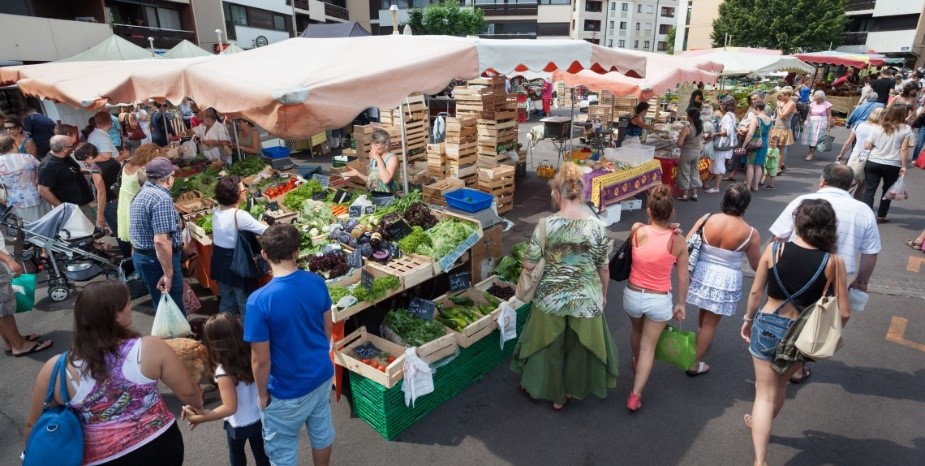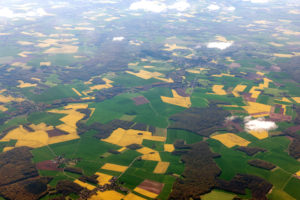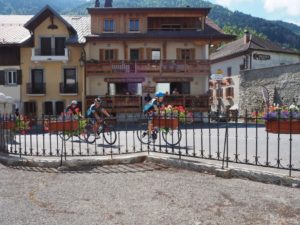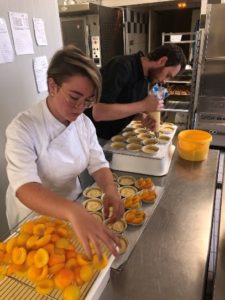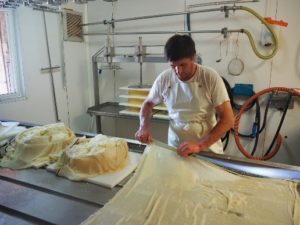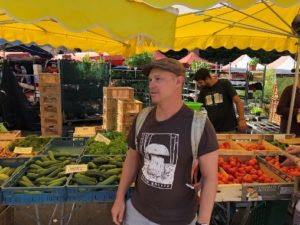In July I had the opportunity to travel through the Haute Savoie region of France. It was billed as a “culinary adventure” by Saveur the Journey. The description is what you might expect: “This trip will focus on visiting and learning from food artisans such as cheese makers, butchers, charcuterie experts, pastry chefs, bakers, winemakers, and more. We will taste and eat the local products through guided (translated) visits, market tours, cooking classes, and hosted meals.”
Since I learned about the trip on COMFOOD—a community food systems listserv hosted by Tufts University—and often the medium is the message, I took a closer look. What came next was irresistible: “Possible discussions include: diversity of the French food system and the importance of small farms; use of chemicals and synthetic fertilizers in Europe; decreased numbers of shoppers in French Markets; the importance of training and efficiency in artisan food production; changes in how and what the French eat; succession plans for farmers and food producers; the cost of food in France; the rise of supermarkets and American shopping culture and its effect on farmers and small food businesses; the importance of French food traditions and resiliency.” WOW! As a food system worker, I was hooked. I rallied a few fellow travelers and spent late winter and spring getting into better shape for the afternoon hikes in the Alps.
What we experienced was even more special than we imagined during those months of anticipation. Our guide, Aaron Schorsch, lived in this region not far from Geneva, Switzerland for two years—farming, making cheese, working in a butcher shop and teaching English in a culinary high school—bringing an anthropologist’s sensibility to the experiences and relationships he cultivated. Most of the locals and artisans we met were people he had worked with and befriended.
I was struck by many contrasts as we interacted with food-makers in this mostly rural region surrounding Thonon-les-Bains, France. I had to keep reminding myself about the structural differences between American and French agricultural landscapes, and each nation’s history, that bear so importantly on our foodways; differences that prevent the U.S. from realizing many of the characteristics that make this region almost the epitome of Slow Food ideals.
The first contrast was evident before we landed in Geneva. Across rural central France were a predominance of small farms and villages in a biodiverse patchwork of cropland and sylvan areas. Aaron highlighted how even in more developed areas, agricultural land is interspersed with residential property, rather than set apart in distinct farming districts. There is a natural integration of farming in everyday life that has been preserved over the centuries. This keeps “where your food comes from” in view and makes farming a known and relatable industry. In the U.S. farms have become massive, pushing farm homes into more remote and increasingly separate contexts, so it’s not surprising that American kids think their food comes from the supermarket
The smallness and integration of farms keeps rural people in close, walkable communities. We visited rural towns with populations of just a few hundred people that support a local bakery, butcher shop, small market store, and one or more restaurants. Most rural towns of this size in the U.S. cannot support a single grocery store, let alone a variety of specialty stores and eateries. It seems once you’re in your car, it’s preferable to drive another 45 minutes to spend a few dollars less on a bag of groceries at Dollar General or Walmart.
These village businesses did not appear to conscript the owners to a life of rural desolation. All we visited were multi-generational, the original owners having handed the reins to willing sons and daughters, who will hand the reins to their children. The businesses, ‘tho small, were investing in growth, updating their retail offerings, upgrading production facilities, and scaling into multi-unit operations dotting the landscape.
We visited a variety of production facilities that were well-designed, modern, cheerful and clean, although clean does not necessarily mean a total absence of microorganisms. In the sunshiny atmosphere of the bakery, pastry kitchen, farmstead cheese factory and butcher shop were a noticeable number of insects, making their way through open doors and windows. The general sentiment among those we met is that Americans are way too uptight about sterilization, and that our immune systems would be better off if they had to work a little harder. After a few days I packed away my hand gel, stopped swatting over our picnic spreads, and let it fly, so to speak. I survived.
Our visit to the bakery was a particularly fascinating lesson in French traditions. The owner operates nine stores from two production centers that deliver raw baguettes continuously to each retail location to be baked onsite from 5AM til closing. His business was unaffected by the anti-carb craze that was the demise of two terrific bread shops near my home in Chicago. In France, food traditions are deeply ingrained, and change does not happen quickly, if it happens at all.
A 1993 decree dictates the production method of the traditional French baguette, a manual process that can take up to 18 hours to mix, shape, proof and bake. The bakery introduced a classique baguette that can be shaped entirely by machines. It sells for 2/3 the price, but une baguette traditionnelle has always outsold the less expensive alternative, and today it represents about 80% of the company’s baguette sales, up from 60% not long ago.
Sticking with tradition goes beyond the baguette. Our guide related his experience selling produce at farmers markets around the area. Aaron worked at a farm that would often experiment with “new” crops. They grew eggplant which sold well at one of the larger markets. But when he took it to mountain villages just a few miles away where eggplant wouldn’t reliably grow, the locals wouldn’t touch it because “We don’t eat that here.”
Compare that with the U.S. where every few years a new food trend or miracle diet disrupts an entire industry as supply chains scramble to respond. I appreciated Aaron’s take on this—while these fleeting fads highlight our obsession with quick fixes and lack of traditional foodways, they also demonstrate that Americans are very willing to try new foods, and that is very good news for us as a nation that needs to embrace a few new foods. We’re already seeing this demonstrated in positive ways with rapidly increasing sales of fresh and minimally processed foods.
One of the most inspiring parts of the trip was visiting the market in Thonon-les-Bains. Outdoor markets continue to be the predominant channel for food purchases, and the market in Thonon is massive. It serves a population of just 35,000 but is easily 5x the size of any market in Chicago. Every Thursday morning hundreds of people leave home and work to meander through the streets and squares to buy fresh produce, dairy, fish, meat (horse!), specialty foods, clothing, jewelry, pots and pans—practically anything you can vend from a tent or trailer. Nearby villages coordinate market days making it possible to shop this way almost every day of the week. Some vendors believe their sales are being impacted by the expansion of grocery chains like Carrefour and Super U, so it remains to be seen if this delightful custom of civic life will eventually succumb to the convenience of the 24/7 grocery store. As I roamed the hundreds of stalls with people of all ages, races, classes and gender making the effort to queue up for fresh foods, that day appeared to be a long way off.
Being immersed in this wonderful food culture made me hopeful that the region’s food traditions will survive even as the population changes demographically and independent food businesses begin to scale into small chains. The unholy trinity of forces—taste, price and convenience—whose worst aspects have shaped much of American food culture, do not appear yet to have had a damaging effect in this region of France, despite the ominous list of “possible discussions” in the tour’s marketing. But it is nothing to take for granted, and we can be thankful that experiences like Saveur the Journey, and organizations like Slow Food, lift up and work to preserve these traditions.
(Cover image from www.ville-thonon.fr/265-foires-et-marches.htm) (All other photos and video courtesy of Kathy Nyquist)

